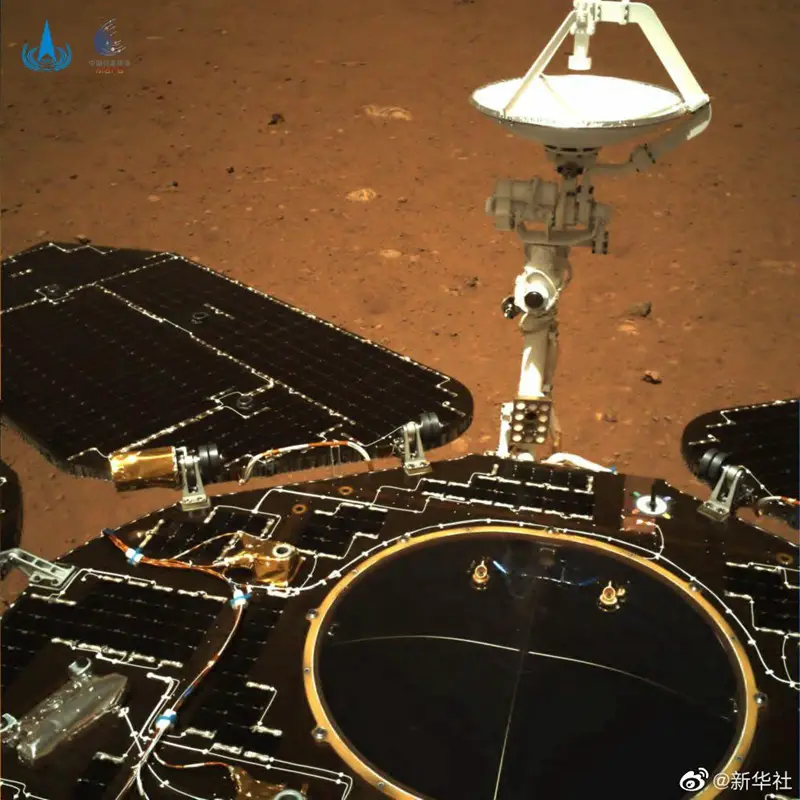By Feng Hua, People’s Daily

An image of Mars taken by rover Zhurong. (Photo/Xinhua)
China’s first Mars rover, Zhurong, drove down from its landing platform to the Martian surface at 10:40 a.m. (Beijing Time), May 22 and started exploring, leaving the first mark of China on the red planet.
It marched 0.522 meters on the surface of Mars to mark the important date.
The China National Space Administration (CNSA) released visuals of the rover driving filmed by its obstacle avoidance cameras.
“The rover left the landing platform on which it had spent 303 days, and touched down on the novel and unfamiliar piece of land that we have long expected, steadily,” Zhang Rongqiao, chief designer of China’s first Mars exploration mission, told People’s Daily.
As China’s first exploration mission to Mars, Tianwen-1 completed orbiting, landing and roving on the red planet at one stroke, which is an unprecedented achievement in the history of aerospace.
Mars rover is a mobile detector that lands on and explores the red planet. The rover Zhurong looks like a beautiful blue butterfly, whose four wings are solar panels for power supply. It is reported that the rover is equipped with advanced active suspension that enables the craft to move like an inchworm, raise its wheels, and lift and lower its chassis.
Chen Baichao, chief director-designer of the rover system from the China Academy of Space Technology (CAST), introduced that the suspension system is able to effectively cope with wheel sinkage. The rover can still retain its mobility even when a wheel malfunctions, he added.
With a mass of 240 kg, Zhurong is 3.3 meters in length, 3.2 meters in width and 1.85 meters in height. It has an expected lifespan of at least 90 Martian days, or about three months on Earth. The rover is equipped with six scientific instruments to study the space environment, topographic features, surface structure of soil, atmosphere (temperature, air pressure, wind velocity and direction), and local magnetic field on Mars.
Zhurong is actually not marching at a high speed on Mars. It operates with a three-Martian day cycle: first day for environmental perception, second day for movement, and the last for scientific exploration, and telemeters data on a daily basis. Due to the harsh Martian environment, the rover can work only one to two hours each time.
As a matter of fact, Zhurong has to overcome a number of difficulties in order to work on Mars. The faint sunlight, low temperature, restricted Earth-Mars communication, poor trafficability and unpredictable sand storms pose major threats to the rover’s existence and patrol mission, said Jia Yang, deputy chief designer of the Mars rover from the CAST.
For instance, the distance between the two planets is 320 million kilometers, and it takes nearly 40 minutes for a signal to travel both ways, which means the rover cannot be controlled in real time, Jia introduced. The temperature on Mars, which falls below 130 degrees below zero Celsius at night, is also a huge challenge for the rover, he added.
What’s more, the wind velocity on Mars could reach 180 meters per second, which is more than three times of the speed of a super typhoon on Earth. Such winds could start huge sand storms that pose severe risks for the existence of the rover. Besides, the sand storms will also impact the power generation of Zhurong.
To cope with these difficulties, the R&D team of the Mars rover has tailored the designing of the craft to match Martian conditions. For instance, regarding the communication problem caused by the long distance between Earth and Mars, Zhurong works autonomously for the most of the time and plans its exploration based on Martian days. Besides, it takes relay communication as a major method of remote control, telemetry and data transmission.
It marched 0.522 meters on the surface of Mars to mark the important date.
The China National Space Administration (CNSA) released visuals of the rover driving filmed by its obstacle avoidance cameras.
“The rover left the landing platform on which it had spent 303 days, and touched down on the novel and unfamiliar piece of land that we have long expected, steadily,” Zhang Rongqiao, chief designer of China’s first Mars exploration mission, told People’s Daily.
As China’s first exploration mission to Mars, Tianwen-1 completed orbiting, landing and roving on the red planet at one stroke, which is an unprecedented achievement in the history of aerospace.
Mars rover is a mobile detector that lands on and explores the red planet. The rover Zhurong looks like a beautiful blue butterfly, whose four wings are solar panels for power supply. It is reported that the rover is equipped with advanced active suspension that enables the craft to move like an inchworm, raise its wheels, and lift and lower its chassis.
Chen Baichao, chief director-designer of the rover system from the China Academy of Space Technology (CAST), introduced that the suspension system is able to effectively cope with wheel sinkage. The rover can still retain its mobility even when a wheel malfunctions, he added.
With a mass of 240 kg, Zhurong is 3.3 meters in length, 3.2 meters in width and 1.85 meters in height. It has an expected lifespan of at least 90 Martian days, or about three months on Earth. The rover is equipped with six scientific instruments to study the space environment, topographic features, surface structure of soil, atmosphere (temperature, air pressure, wind velocity and direction), and local magnetic field on Mars.
Zhurong is actually not marching at a high speed on Mars. It operates with a three-Martian day cycle: first day for environmental perception, second day for movement, and the last for scientific exploration, and telemeters data on a daily basis. Due to the harsh Martian environment, the rover can work only one to two hours each time.
As a matter of fact, Zhurong has to overcome a number of difficulties in order to work on Mars. The faint sunlight, low temperature, restricted Earth-Mars communication, poor trafficability and unpredictable sand storms pose major threats to the rover’s existence and patrol mission, said Jia Yang, deputy chief designer of the Mars rover from the CAST.
For instance, the distance between the two planets is 320 million kilometers, and it takes nearly 40 minutes for a signal to travel both ways, which means the rover cannot be controlled in real time, Jia introduced. The temperature on Mars, which falls below 130 degrees below zero Celsius at night, is also a huge challenge for the rover, he added.
What’s more, the wind velocity on Mars could reach 180 meters per second, which is more than three times of the speed of a super typhoon on Earth. Such winds could start huge sand storms that pose severe risks for the existence of the rover. Besides, the sand storms will also impact the power generation of Zhurong.
To cope with these difficulties, the R&D team of the Mars rover has tailored the designing of the craft to match Martian conditions. For instance, regarding the communication problem caused by the long distance between Earth and Mars, Zhurong works autonomously for the most of the time and plans its exploration based on Martian days. Besides, it takes relay communication as a major method of remote control, telemetry and data transmission.
 Menu
Menu
 China’s rover makes first step on Mars
China’s rover makes first step on Mars
















